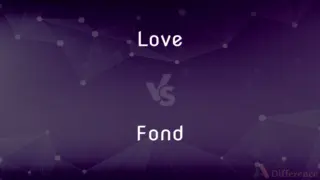Silicon vs. Carbon — What's the Difference?
By Fiza Rafique & Urooj Arif — Updated on April 17, 2024
Silicon is a metalloid widely used in electronics for its semiconductive properties, whereas carbon, a non-metal, is essential for organic chemistry and life.
Difference Between Silicon and Carbon
Table of Contents
ADVERTISEMENT
Key Differences
Silicon is primarily found in nature as part of minerals like sand and quartz, forming a major component of the Earth's crust. Carbon, on the other hand, is the backbone of all known life, essential in organic compounds and found in all living organisms.
Silicon's key role in technology stems from its semiconductive properties, making it indispensable in the manufacture of electronic components like microchips and solar cells. Carbon, whereas, is versatile in forms like graphite for pencils, diamonds for abrasives and jewelry, and as a key player in the chemistry of life.
Silicon forms stable compounds with oxygen, leading to materials with high thermal stability and durability, used in ceramics and glass-making. Carbon, on the other hand, forms strong covalent bonds with other atoms including itself, which allows it to create a vast array of complex molecules, from DNA to proteins and beyond.
In terms of physical properties, silicon is hard and brittle, a poor conductor of electricity in its pure form. Carbon’s allotropes, such as graphite, are good conductors of electricity, while diamond is an excellent thermal conductor but an electrical insulator.
Silicon is used to create solar panels, contributing to green energy solutions. Carbon, however, plays a dual role; it is crucial for life but also a major component in greenhouse gases like CO2, impacting global climate.
ADVERTISEMENT
Comparison Chart
Elemental Category
Metalloid
Non-metal
Primary Use
Electronics, solar cells, glass making.
Organic chemistry, life forms, manufacturing.
Electrical Conductivity
Semiconductor in microelectronics.
Ranges from conductor (graphite) to insulator (diamond).
Natural Form
Found in minerals like quartz, sand.
Exists freely as graphite, diamond; in all organic life.
Environmental Impact
Used in renewable energy (solar panels).
Essential for life; involved in greenhouse gas (CO2).
Compare with Definitions
Silicon
Integral to the development of solar panels due to its semiconductive properties.
Solar panels employ silicon to convert sunlight into electricity.
Carbon
Forms various allotropes including diamond, graphite, and fullerenes.
Diamond and graphite are two well-known allotropes of carbon.
Silicon
A hard and brittle crystalline solid with a blue-grey metallic lustre.
Silicon is used primarily in the manufacture of semiconductors.
Carbon
Used in the manufacture of many synthetic materials like plastics and synthetic fibers.
Carbon compounds are used extensively in plastics.
Silicon
A chemical element with symbol Si and atomic number 14.
Silicon chips are integral to computing technology.
Carbon
Capable of forming double bonds and rings, leading to complex molecular structures.
Carbon's ability to form complex structures makes it indispensable in organic synthesis.
Silicon
Used in the production of glass and ceramics.
Silicon is melted down to produce glass.
Carbon
A nonmetallic element with the symbol C and atomic number 6.
Carbon is the basis for organic chemistry.
Silicon
Predominantly found in the Earth’s crust combined with oxygen as silica or silicates.
The most common form of silicon in the Earth's crust is found in quartz.
Carbon
Essential in the chemistry of life, forming the backbone of organic molecules.
Carbon chains are found in all living organisms.
Silicon
Silicon is a chemical element with the symbol Si and atomic number 14. It is a hard, brittle crystalline solid with a blue-grey metallic lustre, and is a tetravalent metalloid and semiconductor.
Carbon
Carbon (from Latin: carbo "coal") is a chemical element with the symbol C and atomic number 6. It is nonmetallic and tetravalent—making four electrons available to form covalent chemical bonds.
Silicon
A nonmetallic element occurring extensively in the earth's crust in silica and silicates, having both a brown amorphous and a gray lustrous crystalline allotrope, and used doped or in combination with other materials in glass, semiconducting devices, concrete, brick, refractories, pottery, and silicones. Atomic number 14; atomic weight 28.086; melting point 1,414°C; boiling point 3,265°C; specific gravity 2.33 (25°C); valence 2, 4. See Periodic Table.
Carbon
The chemical element of atomic number 6, a non-metal which has two main forms (diamond and graphite) and which also occurs in impure form in charcoal, soot, and coal.
Silicon
A nonmetallic element (symbol Si) with an atomic number of 14 and atomic weight of 28.0855.
Carbon
Carbon dioxide or other gaseous carbon compounds released into the atmosphere, associated with climate change
Fossil fuel consumption and carbon emissions continued to rise
The level of carbon in the atmosphere has been consistently rising
Silicon
A single atom of this element.
Carbon
Symbol C An abundant nonmetallic element that occurs in many inorganic and in all organic compounds, exists freely in amorphous, graphite, and diamond forms and as a constituent of coal, limestone, and petroleum, and is capable of chemical self-bonding to form an enormous number of chemically, biologically, and commercially important molecules. Other significant allotropes include fullerenes and nanotubes. Atomic number 6; atomic weight 12.011; sublimation point 3,825°C; triple point 4,489°C; specific gravity of amorphous carbon 1.8 to 2.1, of diamond 3.15 to 3.53, of graphite 1.9 to 2.3; valence 2, 3, 4. See Periodic Table.
Silicon
(slang) computing
Carbon
A carbon-containing gas, notably carbon dioxide, or a collection of such gases, especially when considered as a contributor to the greenhouse effect
Plans for capturing and sequestering carbon produced by power plants.
Silicon
(slang) computer processor
Carbon
A sheet of carbon paper.
Silicon
Abbreviation of silicon chip
Carbon
A carbon copy.
Silicon
A nonmetalic element analogous to carbon. It always occurs combined in nature, and is artificially obtained in the free state, usually as a dark brown amorphous powder, or as a dark crystalline substance with a meetallic luster. Its oxide is silica, or common quartz, and in this form, or as silicates, it is, next to oxygen, the most abundant element of the earth's crust. Silicon is characteristically the element of the mineral kingdom, as carbon is of the organic world. Symbol Si. Atomic weight 28. Called also silicium.
Carbon
Either of two rods through which current flows to form an arc, as in lighting or welding.
Silicon
A tetravalent nonmetallic element; next to oxygen it is the most abundant element in the earth's crust; occurs in clay and feldspar and granite and quartz and sand; used as a semiconductor in transistors
Carbon
A carbonaceous electrode in an electric cell.
Carbon
(uncountable) The chemical element (symbol C) with an atomic number of 6. It can be found in pure form for example as graphite, a black, shiny and very soft material, or diamond, a colourless, transparent, crystalline solid and the hardest known material. Category:en:Carbon
Carbon
(countable) An atom of this element, in reference to a molecule containing it.
A methane molecule is made up of a single carbon with four hydrogens.
Carbon
A sheet of carbon paper.
Carbon
A carbon copy.
Carbon
A fossil fuel that is made of impure carbon such as coal or charcoal.
Carbon
Carbon dioxide, in the context of climate change. Category:en:Climate change
Carbon neutral
Carbon
A carbon rod or pencil used in an arc lamp.
Carbon
A plate or piece of carbon used as one of the elements of a voltaic battery.
Carbon
(informal) carbon fiber.
Carbon bike frame
Carbon
To cause (someone) to receive a carbon copy of an email message.
When I send it, I'll carbon Julia so she's aware.
Carbon
An elementary substance, not metallic in its nature, which is present in all organic compounds. Atomic weight 11.97. Symbol C. it is combustible, and forms the base of lampblack and charcoal, and enters largely into mineral coals. In its pure crystallized state it constitutes the diamond, the hardest of known substances, occuring in monometric crystals like the octahedron, etc. Another modification is graphite, or blacklead, and in this it is soft, and occurs in hexagonal prisms or tables. When united with oxygen it forms carbon dioxide, commonly called carbonic acid, or carbonic oxide, according to the proportions of the oxygen; when united with hydrogen, it forms various compounds called hydrocarbons. Compare Diamond, and Graphite.
Carbon
A carbon rod or pencil used in an arc lamp; also, a plate or piece of carbon used as one of the elements of a voltaic battery.
Carbon
A sheet of carbon paper.
Carbon
A carbon copy.
The formation of the compounds of carbon is not dependent upon the life process.
Carbon
An abundant nonmetallic tetravalent element occurring in three allotropic forms: amorphous carbon and graphite and diamond; occurs in all organic compounds
Carbon
A thin paper coated on one side with a dark waxy substance (often containing carbon); used to transfer characters from the original to an under sheet of paper
Carbon
A copy made with carbon paper
Common Curiosities
Why is silicon used in electronics?
Its semiconductor properties make it ideal for controlling electrical currents in devices.
What are some common forms of carbon?
Graphite, diamond, and organic compounds are common forms of carbon.
What are the main uses of silicon and carbon?
Silicon is used in electronics and solar cells, while carbon is critical for organic chemistry and materials like diamond and graphite.
How are silicon and carbon obtained?
Silicon is extracted from quartz and sand, while carbon is sourced from organic materials and minerals like coal.
Are there any synthetic forms of silicon similar to synthetic diamonds?
Yes, synthetic silicon crystals are grown for use in electronics and optics.
Can silicon form biological compounds like carbon?
No, silicon does not form the basis for life and complex biological molecules as carbon does.
What is the difference in conductivity between silicon and carbon?
Silicon is a semiconductor, useful in electronics, while carbon forms both conductive and insulative materials.
How does the environmental impact of silicon compare to carbon?
Silicon helps in creating green technologies like solar panels, whereas carbon's role in CO2 emissions is a major environmental concern.
What role does carbon play in climate change?
Carbon emissions from fossil fuels contribute significantly to greenhouse gases and global warming.
Is there a biological role for silicon like carbon?
Silicon is essential in some plants and diatoms but not nearly as universally important as carbon.
How are diamonds and silicon chips made?
Diamonds are formed under high-pressure and high-temperature conditions naturally or synthetically, while silicon chips are manufactured in clean rooms from purified silicon.
Can silicon be used in battery technology?
Yes, silicon is being explored as a material for anodes in lithium-ion batteries due to its high capacity for lithium ions.
How does the thermal conductivity of silicon compare to diamond?
Silicon has decent thermal conductivity, but diamond is one of the best known thermal conductors.
What is the hardest form of carbon?
Diamond is the hardest naturally occurring form of carbon.
What makes carbon essential to life?
Its ability to form stable, complex molecules with itself and other elements is vital for biological molecules.
Share Your Discovery

Previous Comparison
Glug vs. Slug
Next Comparison
Love vs. FondAuthor Spotlight
Written by
Fiza RafiqueFiza Rafique is a skilled content writer at AskDifference.com, where she meticulously refines and enhances written pieces. Drawing from her vast editorial expertise, Fiza ensures clarity, accuracy, and precision in every article. Passionate about language, she continually seeks to elevate the quality of content for readers worldwide.
Co-written by
Urooj ArifUrooj is a skilled content writer at Ask Difference, known for her exceptional ability to simplify complex topics into engaging and informative content. With a passion for research and a flair for clear, concise writing, she consistently delivers articles that resonate with our diverse audience.















































